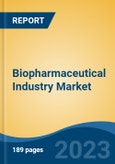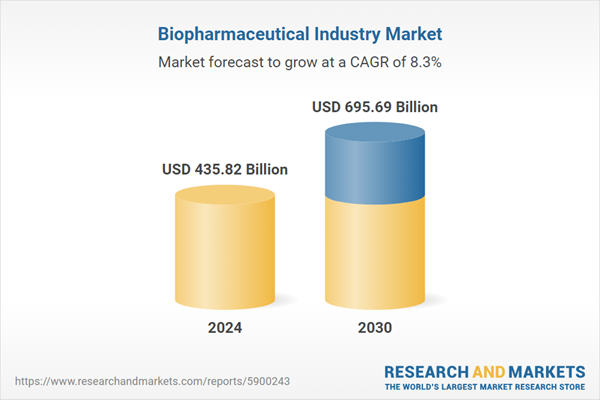Speak directly to the analyst to clarify any post sales queries you may have.
10% Free customizationThis report comes with 10% free customization, enabling you to add data that meets your specific business needs.
The global biopharmaceutical market has been on a consistent growth trajectory for several years. This growth is driven by factors such as an aging global population, increasing prevalence of chronic diseases, rising healthcare expenditures, and the continuous introduction of innovative biopharmaceutical products. The market has demonstrated resilience even in the face of economic downturns, making it an attractive investment opportunity for pharmaceutical companies and investors.
Key Market Drivers
Research and Development Innovations
Research and development (R&D) innovations are at the heart of the biopharmaceutical industry. They are essential for the creation of novel therapies, drugs, and treatments. The importance of R&D innovations can be attributed to several factors. For instance, in February 2025, Zydus Lifesciences launched VaxiFlu-4, India’s first quadrivalent influenza vaccine, representing a major advancement in vaccine technology. Developed at Zydus’s Vaccine Technology Centre in Ahmedabad, it is formulated based on WHO recommendations to protect against emerging influenza virus strains.With technological breakthroughs such as CRISPR-Cas9 gene editing, next-generation sequencing, and artificial intelligence, scientists can delve deeper into the understanding of diseases and develop innovative solutions. R&D innovations enable biopharmaceutical companies to tackle previously untreatable diseases and medical conditions, addressing unmet healthcare needs. Companies that invest heavily in R&D gain a competitive edge by bringing groundbreaking therapies to market, which can lead to substantial profits and market dominance. Continuous R&D ensures a pipeline of new drugs and therapies, fostering long-term sustainability for the biopharmaceutical industry.
Key Market Challenges
Regulatory Hurdles and Compliance Complexity
The biopharmaceutical industry operates in a highly regulated environment due to the critical nature of healthcare products. Regulatory bodies, such as the U.S. Food and Drug Administration (FDA) and the European Medicines Agency (EMA), impose rigorous standards and requirements on the development, testing, and manufacturing of biopharmaceutical products.Meeting these regulatory standards can be a time-consuming and costly process. Companies must invest substantial resources in conducting clinical trials, documenting safety and efficacy data, and ensuring compliance with evolving regulations. Moreover, the variability in regulatory requirements across different countries and regions can pose a significant challenge for global market expansion. Additionally, as biopharmaceutical research advances into newer areas such as gene therapies and cell-based treatments, regulators are often grappling with the development of appropriate guidelines, which can further slowdown product approvals.
Key Market Trends
Biotechnology Advancements and Personalized Medicine
One of the most significant trends in the biopharmaceutical industry is the rapid advancement of biotechnology, particularly in areas like genomics, proteomics, and bioinformatics. These advancements are enabling the development of highly targeted and personalized medicines. Rather than taking a one-size-fits-all approach, biopharmaceutical companies are increasingly tailoring treatments to individual patients based on their genetic makeup, biomarkers, and specific disease characteristics. This trend is transforming the treatment landscape, allowing for more effective therapies with fewer side effects. Personalized medicine not only improves patient outcomes but also reduces healthcare costs by minimizing ineffective treatments and adverse reactions. Biopharmaceutical companies are investing heavily in research to identify biomarkers, develop companion diagnostics, and create therapies that precisely match a patient's genetic profile.Key Market Players
- Abbvie Inc.
- Amgen Inc.
- Bristol-Myers Squibb Company
- Eli Lilly and Company
- Johnson & Johnson
- Novartis AG
- Novo Nordisk AS
- Pfizer Inc.
- GlaxoSmithKline PLC
- F. Hoffmann-La Roche AG
Report Scope:
In this report, the Global Biopharmaceutical Industry Market has been segmented into the following categories, in addition to the industry trends which have also been detailed below:Biopharmaceutical Industry Market, By Product Type:
- Monoclonal Antibodies
- Recombinant Growth Factors
- Purified Proteins
- Recombinant Proteins
- Recombinant Hormones
- Vaccines
- Recombinant Enzymes
- Cell and Gene Therapies
- Synthetic Immunomodulators
- Others
Biopharmaceutical Industry Market, By Therapeutic Application:
- Oncology
- Inflammatory and Infectious Diseases
- Autoimmune Disorders
- Metabolic Disorders
- Hormonal Disorders
- Cardiovascular Diseases
- Neurological Diseases
- Other
Biopharmaceutical Industry Market, By Region:
- North America
- United States
- Canada
- Mexico
- Europe
- France
- United Kingdom
- Italy
- Germany
- Spain
- Asia-Pacific
- China
- India
- Japan
- Australia
- South Korea
- South America
- Brazil
- Argentina
- Colombia
- Middle East & Africa
- South Africa
- Saudi Arabia
- UAE
Competitive Landscape
Company Profiles: Detailed analysis of the major companies present in the Global Biopharmaceutical Industry Market.Available Customizations:
With the given market data, the publisher offers customizations according to a company's specific needs. The following customization options are available for the report.Company Information
- Detailed analysis and profiling of additional market players (up to five).
This product will be delivered within 1-3 business days.
Table of Contents
Companies Mentioned
- Abbvie Inc.
- Amgen Inc.
- Bristol-Myers Squibb Company
- Eli Lilly and Company
- Johnson & Johnson
- Novartis AG
- Novo Nordisk AS
- Pfizer Inc.
- GlaxoSmithKline PLC
- F. Hoffmann-La Roche AG
Table Information
| Report Attribute | Details |
|---|---|
| No. of Pages | 183 |
| Published | March 2025 |
| Forecast Period | 2024 - 2030 |
| Estimated Market Value ( USD | $ 435.82 Billion |
| Forecasted Market Value ( USD | $ 695.69 Billion |
| Compound Annual Growth Rate | 8.2% |
| Regions Covered | Global |
| No. of Companies Mentioned | 10 |









